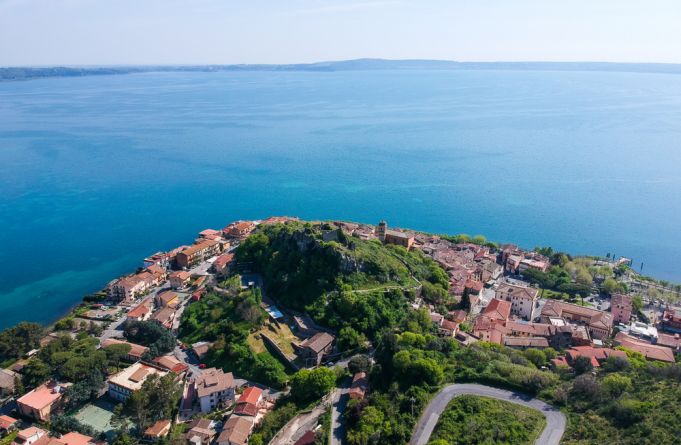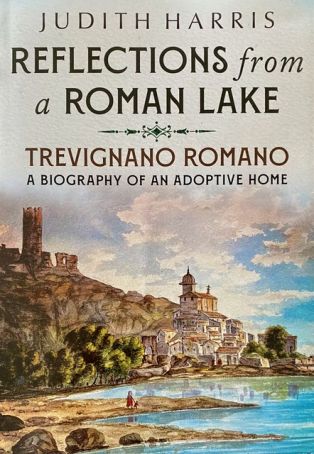As more people seek a quieter pace of life outside Rome, Judith Harris writes about living in nearby Trevignano Romano.
By Mary Jane Cryan
The publication of Judith Harris’s latest book is very timely as real estate brokers are noting a surge of interest for spacious residences in small towns outside of major cities around the world.
Why live in a cramped apartment in Rome, New York or London when you can enjoy a quieter, healthier and less expensive lifestyle with more space for family and working from home.
Reflections from a Roman Lake, Trevignano Romano, a biography of an adoptive home is a love story that Harris dedicates to her adopted home, the smallest of three towns on the perimeter of pristine Lake Bracciano, just an hour north of Rome.
Trevignano, the most ancient of the three, has preserved many of its original traditions and local dialect while Bracciano and Anguillara, on the train line linking Rome and Viterbo, have morphed into dormitory suburbs of the capital with enormous expansion in the past 40 years.
Intricate history
The first part of Reflections describes Trevignano’s long and intricate history, beginning with the prehistoric settlement of La Marmotta discovered and excavated by underwater archaeologists between 1989 and 2009. Archaeologists who excavated the underwater site say that in approximately 5,600 BC it was home to about 500 people.
The prehistoric village was submerged by the lake waters when an earthquake or other natural disaster occurred, similar to what happened to the Roman colony Baiae / Baia in the Bay of Naples.
The site is located under 7m of lake water and nearly 3m of silt which, once removed, have given up precious objects including pottery shards, opium pipes, pirogues, tools, animal bones, food residues and textiles. These are now conserved at the Pigorini Museum in Rome’s EUR. The most important piece according to archaeologists who worked there, is a tiny chubby Venus figurine in soapstone which was discovered inside a sanctuary hut on the lake floor.

Other objects from later Etruscan and Roman times are in Trevignano’s civic museum or can be viewed in situ. These include the marble panel sculpted with rosettes from a Roman public building in the main square and the imposing remains of the aqueduct which was built by Trajan to bring precious spring water from the Trevignano and Bracciano area to the fountains of Rome.
Etruscan tombs
Harris narrates how during her early years in Trevignano she sometimes heard the whirring sound of a mechanical device at night, which meant tombaroli, or tomb-raiders, were searching the nearby Etruscan tombs for precious Attic vases and gold jewellery. Over the years she gained vast knowledge of archaeology in Italy which she passes on to the reader in this and a previous book, Pompeii Reawakened: a Story of Rediscovery.
Ancient sites
Through personal encounters and research in specialised texts Harris gleans information about the ancient sites in Trevignano and shares the more interesting tidbits with her readers, making it easy for the layperson to understand and appreciate the various civilisations that existed on the lakeside: Villanovian settlements, Etruscan necropoli and imposing Roman vestiges.
The second part of the book tells of the strict rules people were subjected to by absentee noble landlords from feudal times right up to the 1950s when battles for reforms finally resulted in grants to the families that had worked the land for centuries. She writes about life in the area during more recent times of war and peace. Harris has interviewed dozens of townspeople, recording their memories of the harsh life endured by the local fishermen and farmers during two world wars when many men of the town were conscripted.
Talks with elderly local people helped to collect eye-witness details of the German military occupation during world war two when German nuns at the Vicarello complex cared for their injured military countrymen. Now abandoned, this picturesque borgo was a spa during Roman times and more recently used as a film set.
Hymn to the good life
The third section of Reflections is a hymn to the good life enjoyed by Trevignano residents today, a series of cameo appearances featuring residents who have left an imprint on the town over the centuries from 17th-century saints to ferocious princes, the blind mailman and the pioneer teacher of the hearing-impaired, to sculptors and bogus miracle workers.
From a tiny, rather isolated lakeside borgo the town has expanded, welcoming many expats who enjoy living in the area today. Jackie Bennett Leto who came to live here in 1979 xplained the phenomenon, mentioning the magical Etruscan atmosphere, the simple fishing village life and micro climate which make Trevignano a perfect place for wine enthusiasts, painters and horse riders.
Peaceful lakefront
For a recent newcomer to Trevignano the location is ideal, for it is steeped in ancient history and on the doorstep of the Tuscia region while still accessible to Rome and its amenities. Nature lovers enjoy the surrounding national forest land, windsurfing on majestic Lake Bracciano, as well as strolling along the peaceful lakefront, having an open air meal or aperitivo at one of the restaurants and cafes.
Recently the Lazio region has given funds to continue the bike path around the lake begun under a previous administration and more money to improve the surrounding parklands. However there are also a few problems. In the chapter Lake at Risk Harris denounces the present state of the lake’s health, due to climate change and reduction of its water level.

The final chapter of Harris’s book Flight, is prompted by the presence near Trevignano of three interesting centres: the historic Vigna di Valle Aeronautic Museum, a small airport (Scuola di Volo Club Arrow) for ultralight aircraft and the centre for Rapacious Birds (Centro Volo Rapaci).
The sprawling aeronautic museum at Vigna di Valle, a sea plane station during world war one, now houses dozens of original historic airplanes and a few unexpected curiosities: the silk remains of a giant hot air balloon which flew from Paris to Bracciano in 1804, and the embalmed dog of Umberto Nobile of dirigible and “Red Tent” fame.
Five pages of footnotes and a vast bibliography complete this extremely interesting and thorough exploration of Judith Harris’s adoptive hometown of Trevignano.
See website for book trailer and purchasing choices. Reflections from a Roman Lake is available in ebook form or hardback (Fonthill Media, €26).
Before searching for a new country residence, Judith Harris called historic Palazzo Doria Pamphilj home. Among the real estate she turned down was a property badly in need of restoration in Vetralla. Serendipitously this became my new home in 1993 and the subject of a bilingual book Painted Palazzo/Palazzo Dipinto (Etruria Editions/Archeoares).
Cover photo ValerioMei / Shutterstock.com. This article was published in the March 2021 online edition of Wanted in Rome magazine.
General Info
View on Map
Trevignano Romano: Reflections from a Roman lake
00069 Trevignano Romano, Metropolitan City of Rome, Italy

















